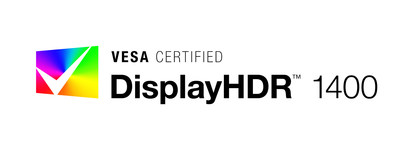

SAN JOSE, Calif., Sept. 4, 2019 /PRNewswire/ -- The Video Electronics Standards Association (VESA®) today announced that it has published the first major update to its widely adopted High-Performance Monitor and Display Compliance Test Specification (DisplayHDR), which is the display industry's first fully open standard specifying high dynamic range (HDR) quality. The updated spec, DisplayHDR version 1.1, includes tighter performance requirements, including for luminance and color gamut, as well as new test requirements, such as for active dimming, to address recent advances in HDR technology. Companies can begin certifying their display products under the new DisplayHDR 1.1 spec today. In addition, VESA will continue to allow products to be certified under the previous DisplayHDR 1.0 spec through the end of May 2020 in order to allow for products already in development that have been designed to meet the original spec, which was published in November 2017.

In related news, VESA also announced that it has added a new 1400 performance level to the DisplayHDR standard, which targets professional content creators. The DisplayHDR 1400 level requires a dynamic contrast ratio that is 3.5X greater than the DisplayHDR 1000 level. ASUS will demonstrate the industry's first pre-certified display for the DisplayHDR 1400 spec at IFA 2019, being held in Berlin, Germany, September 6-11, in Messe Berlin in Hall 12, Booth 110. These latest developments reflect continued strong momentum for the DisplayHDR standard, which has more than 125 display models certified under the logo program to date.
"Since we launched the DisplayHDR compliance test specification nearly two years ago, display manufacturers have made excellent progress in refining the performance and capabilities of their HDR displays beyond what was originally defined in the standard. To represent the gains that the display ecosystem has made in that time, VESA has updated the DisplayHDR standard with substantially tighter performance metrics," stated Roland Wooster, chairman of the VESA task group responsible for DisplayHDR, and the association's representative from Intel Corporation for HDR display technology. "While systems that already received DisplayHDR certification under the existing 1.0 spec are not required to recertify their products under DisplayHDR version 1.1, we believe that many of the systems that passed the original spec will also pass the new 1.1 spec. Going forward, we expect that the majority of new devices will be certified to DisplayHDR 1.1, resulting in an even greater and more consistent HDR experience for consumers."
The DisplayHDR 1.1 specification includes a number of key performance updates, such as:
DisplayHDR 1400: A New HDR Performance Level for Content Creators
In addition to updating the DisplayHDR compliance test specification (CTS), VESA has also introduced a new 1400 performance tier targeting professional content creators. This higher, premium performance tier provides a 40 percent increase in luminance and a 2.5X reduction in black level compared to the DisplayHDR 1000 tier – increasing the contrast range by 350 percent. Color gamut performance requirements have also been increased for the first time, from 90 percent to 95 percent of DCI-P3-D65 – a visibly noticeable difference compared to the 500/600/1000 tiers. Another key feature of the new DisplayHDR 1400 tier is that it requires 900 nits of brightness for full-screen long-duration (30 minute) testing, which provides for a rock-solid stable luminance-based display for professional and prosumer video editing.
"As a long-time maker of leading professional displays, ASUS knows that true-to-life visual accuracy and stable, reliable performance are critical to content creators," said Vincent Chiou, associate vice president of the ASUS Display Business Unit. "With the latest DisplayHDR 1400 standard, VESA enables a new level of display realism, giving creators a new way to see their content and bring their projects to life. Delivering HDR performance at this level is difficult, so we are excited and proud to ship ASUS ProArt Display PA32UCG, the world's first pre-certified DisplayHDR 1400 monitor. ProArt Display PA32UCG offers exceptional performance and stability with peak white brightness of 1600 nits and a sustained full-screen brightness of 1000 nits. It's an ideal companion for content creators of all types to help them realize their creative visions."
"The ProArt Display PA32UCG from ASUS can display 1000 nits full screen, which matches the best of today's reference monitors at any cost, and provides consistency when mastering. It also hits a spectacular 1600 nits peak, which is rare and helps immensely when preparing images for tone mapping. To have both these specifications in one display at this price point is truly amazing. VESA has recognized the need for higher quality mastering specifications and announced the VESA DisplayHDR 1400 standard. The PA32UCG is VESA DisplayHDR 1400 pre-certified. ASUS has once again raised the bar for HDR and invited everyone to the party. I am looking forward to collaborations with many more HDR pioneers now that the PA32UCG is available," stated Kevin Shaw, president of Colorist Society International and co-founder of International Colorist Academy.
A specification performance summary table and additional documentation for the VESA DisplayHDR standard, including the updated DisplayHDR CTS version 1.1, is available for download at https://displayhdr.org/performance-criteria/
About VESA
The Video Electronics Standards Association (VESA) is an international, non-profit standards association representing a global network of more than 280 hardware, software, computer, display and component manufacturers committed to developing and promoting the electronics industry. For 30 years, VESA has created and supported simple, universal and cross-product solutions for today's video and electronics industry. The association's standards include DisplayPort™, the industry replacement for DVI, LVDS and VGA. DisplayPort utilizes a state-of-the-art digital protocol and provides an expandable foundation to enable astonishing digital display experiences. For more information on VESA, please visit http://www.vesa.org/.
VESA® is a registered trademark and DisplayPort™ is a trademark of VESA. All other trademarks, service marks, registered trademarks, and registered service marks are the property of their respective owners.

SOURCE Video Electronics Standards Association (VESA)
